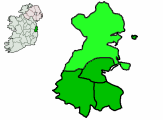芬戈語
| 芬戈語 | |
|---|---|
| Fingallian | |
| 母語國家和地區 | 愛爾蘭 |
| 區域 | 芬戈郡 |
| 語言滅亡 | 19世紀中葉 |
| 語系 | 印歐語系
|
| 早期形式 | |
| 語言代碼 | |
| ISO 639-3 | 無(mis) |
| Glottolog | east2834[1]fing1234[2] |
芬戈語是一種已滅絕的盎格魯語,曾分佈在愛爾蘭芬戈郡。據信它是在諾曼征服愛爾蘭時被帶到愛爾蘭島上的中古英語方言,到19世紀中葉滅絕。芬戈語的資料很稀少,人們相信它和分佈在韋克斯福德郡的約拉語很相似。[3]
現存芬戈語文學作品主要是兩份諷刺詩或打油詩,短的叫做《芬戈之舞》,長得多的篇名叫《愛爾蘭煉獄》(Purgatorium Hibernicum,拉丁語)。兩篇詩的作者姓名已佚,可能是非母語者嘲笑芬戈人的口音而作,因而它們的語言學價值並不高。
歷史
[編輯]
芬戈語分佈在芬戈郡,這一地區傳統上指都柏林郡在托爾卡河以北的部分。芬戈語分佈的範圍挨着北部邊界線。「芬戈(Fingal)」一名來自愛爾蘭語Fine Gall「外鄉人的土地」,可能是指當地的諾斯人移民。語言學家索默費特認為芬戈語可能受過諾斯語影響,但後來學者們沒有發現相關的證據。[4]:196–197
芬戈語和韋克斯福德郡的約拉語據信都分化自中古英語,是1169年諾曼征服愛爾蘭之後的古英語使用者帶來的。中古英語在愛爾蘭東南部的地位一度十分穩固,直到14世紀當地發生再蓋爾化,英語被重新代替。約拉語和芬戈語是這一支方言的僅存後裔。[5]:197
《芬戈之舞》
[編輯]這首詩是最可能由芬戈語母語者寫的,是一首簡短的三段詩,寫於約1650至1660年間。[6]:198這首詩描寫一個男子去鬥牛場(17世紀愛爾蘭曾流行鬥牛)見那裏的舞者。雖然這首詩寫下的時候似乎經歷過標準化,但仍保留了芬戈語的特徵,如將「what」寫作「fat」,將「when」寫作「fen」。其他例子如用「ame」表示「他們(賓格)」,用「abateing」表示「緊鄰」。[7]
《芬戈之舞》 c.1650
On a day in the Spring,
As I went to bolring
To view the jolly Daunciers,
They did trip it so high
(Be me shole!) I did spee [By my soul, I did spy]
Six Cunts abateing Seav'n hairs.
But wondering on 'ame,
Fat make 'em so tame [溫順],
Fen de catch at their plack-keet,
The maids of y-yore
Wou'd y-cree, and y-rore,
And y-make o foul Rac-keet.
But fire take 'ame, [to hell with them!]
They made me ashame,
And when I went home to me weef
And told her the Chaunce [chance,此處意為「理由」]
Of the Maids in the Daunce,
'Peace thy prateing', say'd shee, 'for dee [thy(「你的」)] Leef!' [「看在上帝份上,小點聲!」]
《愛爾蘭煉獄》(Purgatorium Hibernicum)
[編輯]《愛爾蘭煉獄》是針對羅馬詩人維吉爾《埃涅阿斯紀》的一首幽默而下流的諷刺詩。現存有3個版本:原始的手稿(Purgatorium Hibernicum);題為「芬戈人的諷刺詩:維吉爾《埃涅阿斯紀》第六卷a la mode de Fingaule」(The Fingallian Travesty: the Sixt Book of Virgill's Aenoeids a la mode de Fingaule)(1670–5)的手稿;題為「The Irish Hudibras」或「The Fingallian Burlesque」(芬戈滑稽劇) (1689)的印本。[6][8]
維吉爾筆下的王子埃涅阿斯,及其愛人黛朵被換成了一個笨拙的年輕芬戈人Nees和一個粗俗的還俗修女Dydy。所有角色的名字都被換得更具「愛爾蘭色彩」,故事發生地點的地名也變成了芬戈郡的地名。詩中給盎格魯-愛爾蘭讀者提供的包袱:Nees和Dydy用芬戈土話對罵。雖然作詩的意圖顯然是要嘲笑芬戈人的口音,但這首詩用詞之生動、修辭之豐富,反而令其文學價值大大凸顯。
下面的節選給出了質量較高的芬戈語示例。文中Nees再次遇到了Dydy,發覺她臉色蒼白,覺得也許自己把「火焰」(指性病)傳染給了她。芬戈語用V不用W;'suggam'是一種草繩;Ful dea ro借自愛爾蘭語fuil Dé, a rogha「上帝之血,我的甜心」。
- 'Sure, Sure!' sayes Nees, 'dis me old vench is!'
- But when he drew more neare her quarters,
- And know her by her suggam garters,
- 'Ful dea, ro, dou unlucky jade,
- I'll chance upon dee! Art thou dead?
- Fat devill vas be in dee, vench?
- Vas he soe hot is cou'd no quench
- De flame?' Indeed, oh no! but Nees chief
- Occasion is of all dis mischeif'.
- 'I, Nees', sayes she in mighty snuffe,
- 'and be! is tink is varm enough,
- If dou cam shance but to find out
- Dee old consort to have a bout –
- and den, fen dou has play'd de vagge,
- to give me, as before, de bagge!
- Butt I will vatch de vales, Nees,
- And putt foile on dee by dis chees,'
之後Dydy大發雷霆。
《愛爾蘭書信》
[編輯]John Dunton的《愛爾蘭書信》(1698) 中寫道,芬戈人「有一套只在自己人里用的話,用愛爾蘭語根本聽不懂,用英語也只能理解一點點」。Dunton在信中給出了一段語例,是一名母親在善漁獵的兒子墓前發出的悲嘆。注意a roon和moorneeng兩個詞分別來自愛爾蘭語a rúin「(秘密的)愛人」(呼格)和múirnín「愛」(字面「小小的信任」):
|
|
這一段可大致翻譯為:
|
現代芬戈英語
[編輯]
雖然芬戈語早已滅絕,但芬戈郡當地方言有大量芬戈語詞彙保留下來,特別是在(現為都柏林一個大面積郊區)、Skerries、Rush、Lusk、Donabate、Garristown、Oldtown、Balrothery、Portrane、Naul等傳統芬戈城鎮及鄉村內。這些芬戈語單詞的主要資料來源是民俗學期刊《Béaloideas》中J. J. Hogan和Patrick O'Neill寫的一篇文章,以及Patrick Archer一本關於芬戈民間傳說的書《芬戈傳說》中。
Archer書中記錄的詞有:
- Cinnit(C發/k/音)騙子;
- Cloustered被衣服覆蓋的;
- Dalk荊棘,愛爾蘭語dealg
- Dawney脆弱;
- Glauming摸索;
- Lawneyday感嘆詞,表感嘆或驚訝,愛爾蘭語Láine Dé
- Mullacking在泥濘中勞作或行走;
- Possing濕透;
- Rossie身材粗壯的女性;
- Scut卑鄙的矮子
Hogan & O'Neill提供的詞有:
- Barney爭吵;
- Bunched被毀、結束了的;
- Buthoon失誤,愛爾蘭語Botún
- Clift形容平時細心的人粗心犯錯;
- Cobby奸詐;
- Dugging用拳頭打架;
- Foopah失誤,法語faux pas
- Gollockers眼(蔑稱);
- Go-boy暗中傷人的人;
- Launa-wallya「一肚子」,愛爾蘭語Lán a' mhála(「一袋」[9])
- Malavogue擊敗;
- Moggy肥胖的懶漢;
- Randyvoo人們聊天的場所,法語rendez-vous
- Raucie四處閒逛的女孩;
- Simmy-saumy看上去很蠢的人;
- Squib夥計;
- Tamboo破舊的房子;
- Whack無人,無事物。愛爾蘭語faic
另見
[編輯]註釋
[編輯]- Archer, Patrick. Fair Fingall. An Taisce (reprint). 1975.
- Hogan, J. J.; O'Neill,Patrick C. A North County Dublin Glossary. Béaloideas 17. 1947: 262–283.
- Kerrigan, John. Archipelagic English
 . Oxford University Press. 2008: 64. ISBN 978-0-19-818384-6.
. Oxford University Press. 2008: 64. ISBN 978-0-19-818384-6. - McCrum, Robert; Cran, William; MacNeil, Robert. The Story of English
 . Penguin (Non-classics). 1993: 182. ISBN 0-14-015405-1.
. Penguin (Non-classics). 1993: 182. ISBN 0-14-015405-1.
參考
[編輯]- ^ Hammarström, Harald; Forkel, Robert; Haspelmath, Martin; Bank, Sebastian (編). Irish Anglo-Norman. Glottolog 2.7. Jena: Max Planck Institute for the Science of Human History. 2016.
- ^ Hammarström, Harald; Forkel, Robert; Haspelmath, Martin; Bank, Sebastian (編). Fingallian. Glottolog 2.7. Jena: Max Planck Institute for the Science of Human History. 2016.
- ^ Bliss, Adam James: Spoken English in Ireland 1600 – 1740, pp194ff
- ^ Hickey, Raymond. Dublin English: Evolution and Change. John Benjamins Publishing. 2005. ISBN 90-272-4895-8.
- ^ Hickey, Raymond. Dublin English: Evolution and Change. John Benjamins Publishing. 2005. ISBN 90-272-4895-8.
- ^ 6.0 6.1 Hickey, Raymond. Dublin English: Evolution and Change. John Benjamins Publishing. 2005. ISBN 90-272-4895-8.
- ^ Carpenter, Andrew. Verse in English from Tudor and Stuart Ireland. 2003: 310. ISBN 9781859183731.
- ^ Carpenter, Andrew, Verse in English from Tudor and Stuart Ireland, pp 411 – 16
- ^ Irish translation of 'bagful'. www.focloir.ie. [2022-12-06]. (原始內容存檔於2022-12-06).
